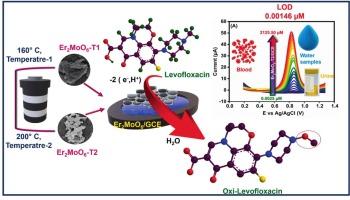温度优化Er2MoO6纳米材料对环境监测中抗生素左氧氟沙星的电化学检测
IF 6.7
2区 工程技术
Q1 ENGINEERING, CHEMICAL
引用次数: 0
摘要
左氧氟沙星(LFX)由于其结构稳定性和理化性质而被广泛应用于医疗保健和水产养殖,其残留物可在环境中持续存在并对人类健康构成重大风险。然而,传统的传感器往往缺乏检测复杂分子化合物所需的效率和灵敏度。在这项工作中,开发了一种基于温度优化的钼酸铒(Er2MoO6)电化学传感器,用于高灵敏度和选择性检测LFX。Er2MoO6纳米粒子通过水热法在两种不同温度(160°C和200°C)下合成,表现出优异的稳定性和可重复使用性。值得注意的是,在200°C下合成的样品(Er2MoO6-T2)在结晶度、形貌和表面性能方面都有显著改善。Er2MoO6-T2修饰的玻碳电极检出限为0.00146 μM,线性范围宽(0.0025 ~ 2125.5 μM),具有良好的选择性、重复性和长期稳定性。此外,经过温度优化的Er2MoO6纳米颗粒在复杂基质(如人类尿液、血液、湖水和池塘水)中的回收率高达98.6%,证实了传感器在实际应用中的可靠性。这项研究强调了er2moo6电极作为抗生素监测的高性能电化学平台的潜力。本文章由计算机程序翻译,如有差异,请以英文原文为准。

Enhanced electrochemical detection of the antibiotic levofloxacin using temperature optimized Er2MoO6 nanomaterials for environmental monitoring
Levofloxacin (LFX) is widely used in healthcare and aquaculture due to its structural stability and physicochemical properties, which allow its residues to persist in the environment and pose significant risks to human health. However, conventional sensors often lack the efficiency and sensitivity required for detecting complex molecular compounds. In this work, a temperature-optimized erbium molybdate (Er2MoO6)-based electrochemical sensor was developed for the highly sensitive and selective detection of LFX. The Er2MoO6 nanoparticles, synthesized via a hydrothermal process at two different temperatures (160 °C and 200 °C), exhibited excellent stability and reusability for sustained sensing. Notably, the sample (Er2MoO6-T2) synthesized at 200 °C demonstrated significant improvements in crystallinity, morphology, and surface properties. The Er2MoO6-T2 modified glassy carbon electrode achieved an ultra-low detection limit of 0.00146 μM, a wide linear range (0.0025–2125.5 μM), and outstanding selectivity, reproducibility, and long-term stability. Furthermore, the temperature-optimized Er2MoO6 nanoparticles enabled high recovery rates of 98.6 % in complex matrices such as human urine, blood, lake water, and pond water, confirming the sensor's reliability for real-world applications. This study highlights the potential of Er2MoO6-based electrodes as high-performance electrochemical platforms for antibiotic monitoring.
求助全文
通过发布文献求助,成功后即可免费获取论文全文。
去求助
来源期刊

Journal of water process engineering
Biochemistry, Genetics and Molecular Biology-Biotechnology
CiteScore
10.70
自引率
8.60%
发文量
846
审稿时长
24 days
期刊介绍:
The Journal of Water Process Engineering aims to publish refereed, high-quality research papers with significant novelty and impact in all areas of the engineering of water and wastewater processing . Papers on advanced and novel treatment processes and technologies are particularly welcome. The Journal considers papers in areas such as nanotechnology and biotechnology applications in water, novel oxidation and separation processes, membrane processes (except those for desalination) , catalytic processes for the removal of water contaminants, sustainable processes, water reuse and recycling, water use and wastewater minimization, integrated/hybrid technology, process modeling of water treatment and novel treatment processes. Submissions on the subject of adsorbents, including standard measurements of adsorption kinetics and equilibrium will only be considered if there is a genuine case for novelty and contribution, for example highly novel, sustainable adsorbents and their use: papers on activated carbon-type materials derived from natural matter, or surfactant-modified clays and related minerals, would not fulfil this criterion. The Journal particularly welcomes contributions involving environmentally, economically and socially sustainable technology for water treatment, including those which are energy-efficient, with minimal or no chemical consumption, and capable of water recycling and reuse that minimizes the direct disposal of wastewater to the aquatic environment. Papers that describe novel ideas for solving issues related to water quality and availability are also welcome, as are those that show the transfer of techniques from other disciplines. The Journal will consider papers dealing with processes for various water matrices including drinking water (except desalination), domestic, urban and industrial wastewaters, in addition to their residues. It is expected that the journal will be of particular relevance to chemical and process engineers working in the field. The Journal welcomes Full Text papers, Short Communications, State-of-the-Art Reviews and Letters to Editors and Case Studies
 求助内容:
求助内容: 应助结果提醒方式:
应助结果提醒方式:


